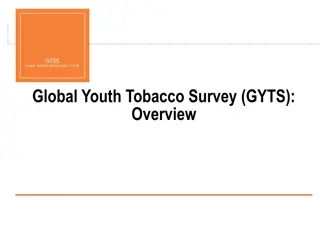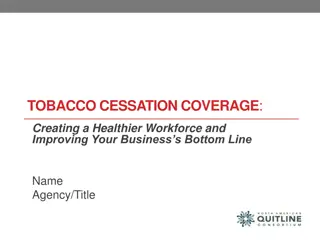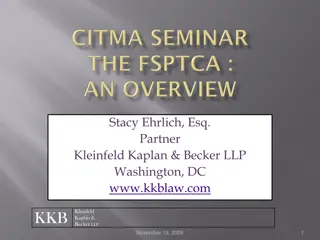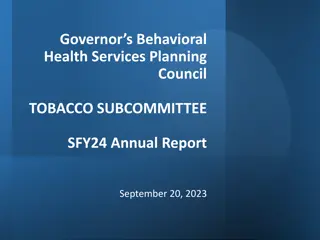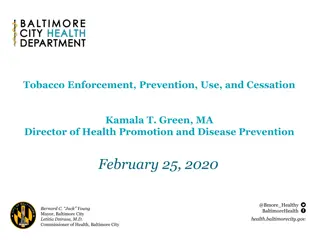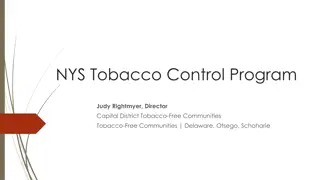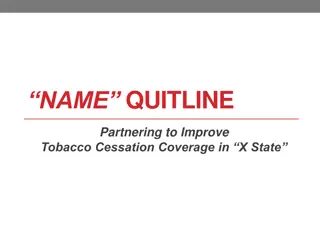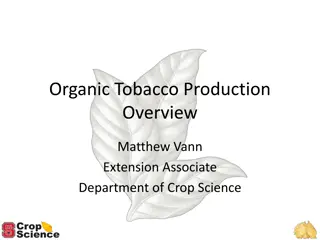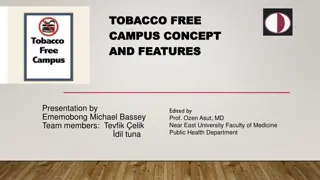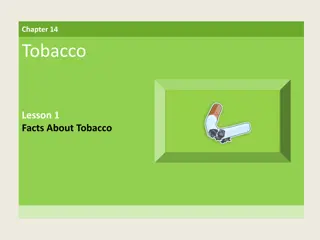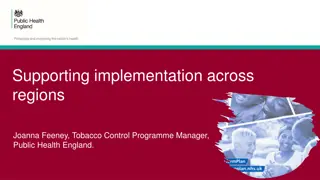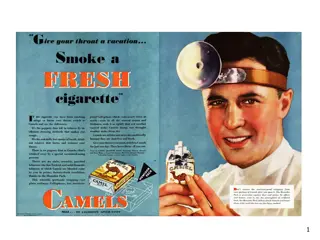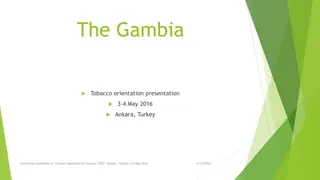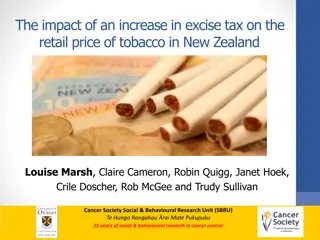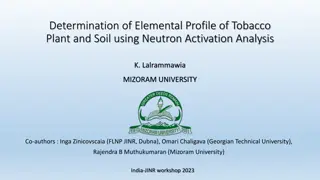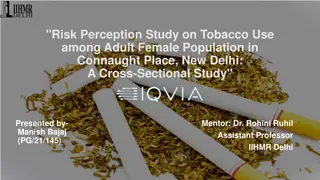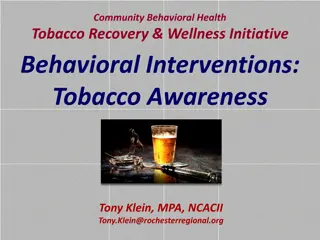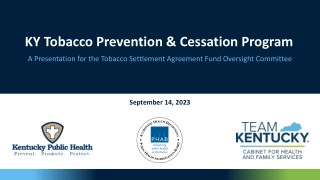Native Communities Tobacco Intervention Skills Certification Program
Certification program focusing on tobacco intervention skills for Native communities, covering unhealthy behaviors, chronic diseases prevalent among Native populations, and strategies for behavior modifications. The program aims to address the high rates of tobacco use and its associated health risks within Indigenous groups.
- Native Communities
- Tobacco Intervention
- Certification Program
- Chronic Diseases
- Behavior Modification
Download Presentation

Please find below an Image/Link to download the presentation.
The content on the website is provided AS IS for your information and personal use only. It may not be sold, licensed, or shared on other websites without obtaining consent from the author. Download presentation by click this link. If you encounter any issues during the download, it is possible that the publisher has removed the file from their server.
E N D
Presentation Transcript
BASIC TOBACCO INTERVENTION SKILLS CERTIFICATION FOR NATIVE COMMUNITIES STEPHANIE BLISS, MS INTER-TRIBAL COUNCIL OF MICHIGAN THERESA CARINO, M.ED, RED STAR INNOVATIONS
Welcome Name Tribe & Program Experience Welcome exercise
Guidebook Introduction Introduction Pages 1-13 Background information 6 Learning Modules Pages 15-98 Learning objectives Information, learning activities, videos Appendices Materials
Unhealthy Behaviors (Introduction~15 minutes) Learning Objectives: The relationship of unhealthy behaviors and chronic disease Chronic diseases that are prevalent among Native Communities Brief interventions as a technique to alter high-risk behaviors Five A Model
Unhealthy behaviors Cause Disease At least 50% of deaths in the US from the ten leading causes of death are strongly linked to lifestyle-related behaviors, such as tobacco use, poor dietary habits and inactivity, alcohol misuse, illicit drug use and risky sexual practices.
Watch & Learn Health Risk Behaviors DVD Chapter 1
Native Communities and Chronic Disease Diabetes-rates among certain tribes are among the highest in the world Cardiovascular Disease-heart disease is the leading cause of death among AI/AN Cancer-nationally, from 2003-2007, AI/AN men were 80% more likely to have liver cancer, Native women are 2.6 times more likely to have liver cancer Asthma-14.2% of adults and 10% children diagnosed in 2009 Maternal & Child Health-in 2001 AI had the highest rate of Sudden Infant Death Syndrome Obesity-is a major health problem in AI communities
Native Communities and Chronic Disease Rates of death from disease for American Indian and Alaska Native (AI/AN) people are as follows: 1. Heart disease 2. Cancer 3. Unintentional injuries 4. Diabetes 5. Chronic liver disease and cirrhosis 6. Stroke 7. Chronic lower respiratory disease 8. Suicide 9. Nephritis, Nephrotic syndrome, and Nephrosis 10.Influenza and pneumonia (CDC, 2006) page 6
Brief Interventions A brief intervention is a low intensity, but meaningful, interaction between two or more people with the ultimate goal of assisting the individual in making a health lifestyle change to achieve optimal health outcomes HealthCare Partnership programs are based on the Five A construct-first developed by the National Cancer Institute and later expanded by the U. S. Department of Health and Human Services Integrating low-intensity interventions into clinical settings can help to improve and even save lives
The Five A Model Ask .about present and historical information related to the unhealthy behavior Advise .about the health hazards of current behavior using motivational interviewing techniques Assess .current commitment to consider changing unhealthy behavior Assist .in developing a healthy life plan, to self- manage change and move toward healthy behavior Arrange .to follow up in order to support success; refer to local and national resources
Watch & Learn Health Consequences of Commercial Tobacco DVD Chapter 2
Health Consequences of Commercial Tobacco (Module 1~15 minutes) Learning Objectives: Know statistics related to AI/AN commercial tobacco use, health, and disease prevalence Understand how secondhand and thirdhand smoke endangers health Be able to screen and assess for tobacco use and exposure to environmental tobacco smoke
Tobacco and Disease The bad news is . 1 in 5 people in the United States die each year from commercial tobacco use 1,215 people per day The good news is . Less than 3 minutes (180 seconds) of commercial tobacco dependence counseling can increase quit rates by 60% The right medications can potentially double tobacco quit rates Multiple behavioral interventions-boost those rates even higher
Watch & Learn Tobacco Dependence Treatment Works DVD Chapter 3
Tobacco Use Interventions Matter Treatment reduces costs to the community People want to quit-more than 70% of those that use commercial tobacco report wanting to quit Treatment is effective We can save lives
Native Health and Tobacco (page 19) High prevalence rates compared to their ethnic/racial counterparts 36% of adult AI/AN reported smoking cigarettes (2008) Men 42.3%-Women 22.4% 17.8 % AI/AN women smoke during pregnancy Youth have the greatest cigarette smoking prevalence of all race/ethnic groups
Smokeless Tobacco (page 20) Not a safe alternative to smoking tobacco Nicotine absorbed from smokeless tobacco is 3-4 times the amount delivered by a cigarette 28 cancer-causing agents Native adults had the highest use of smokeless tobacco out of all race/ethnic groups (2008) Native youth living on reservations have the highest smokeless tobacco use of any other ethnic group
Environmental Tobacco Smoke (page 21) Environmental Tobacco Smoke (secondhand smoke) is dangerous at any level Secondhand smoke is more toxic than smoke taken in by smoking-2-3 times more nicotine, about 10 times the carbon dioxide and as much as 30 times the toxins Women married to men who smoke cigarettes have a 91% greater risk of heart disease Secondhand smoke results in hospitalization and death for children
Environmental Tobacco Smoke (page 22) Components of secondhand smoke 4,000 chemical compounds, 200 are poisons and more than 69 cause cancer Smoke-filled room is up to 6 times more air pollution than a busy highway Secondhand smoke remains in an enclosed area for approximately 2 weeks before the air is clean* About 60% of children ages 3-11 are exposed to environmental smoke, by age 5 each of them will have inhaled the equivalent of 102 packs of cigarettes
Watch & Learn Environmental Tobacco Smoke DVD Chapter 4
Health Consequences of Involuntary Exposure to Tobacco Smoke (page 23) Secondhand smoke causes premature death and disease in children and adults who do not smoke Children exposed to secondhand smoke are at an increased risk of sudden infant death syndrome (SIDS), acute respiratory infections, ear problems, and more severe asthma-slow growth in their lungs Exposure to secondhand smoke has immediate adverse effects on the cardiovascular system and causes coronary heart disease and lung cancer No risk-free level of exposure to secondhand smoke Millions of adults and children are exposed to secondhand smoke Cleaning the air or ventilating buildings cannot eliminate exposure of secondhand smoke
Thirdhand Smoke (page 24) Thirdhand smoke is the term given to the residual of tobacco contamination that settles into the environment and stays there after a cigarette has been put out Tar and nicotine (along with other chemical particles) can linger on clothes, hair, upholstery, drapes, and other items in a room Nicotine remains on surfaces for days and weeks- carcinogens are then created over time and can be inhaled, absorbed or ingested Children of caregivers/parents are at a very high risk of thirdhand smoke exposure and contamination-young children can ingest tobacco residue by putting their hands in their mouths after touching contaminated surfaces
Regina Benjamin, M.D., M.B.A, U.S. Surgeon General There is no safe level of exposure to tobacco smoke. Every inhalation of tobacco smoke exposes our children, our families, and our loved ones to dangerous chemicals that can damage their bodies and result in life-threatening diseases such as cancer and heart disease.
Understanding Tobacco Dependence (Module 2~20 minutes) Learning objectives: Understand commercial tobacco dependence as a chronic disease Be aware of the complex nature of tobacco dependence and nicotine addiction Be able to cite the three links in the chain of tobacco dependence
Watch & Learn Three-Link Chain DVD Chapter 5
Understanding Tobacco Dependence (page 29) Cigarettes and other forms of tobacco are addictive Nicotine is the drug in tobacco that causes addiction The physiological and behavioral processes that determine nicotine addiction are similar to those that determine addiction to drugs such as heroin and cocaine Read quote on the bottom of the page
The Three-Link Chain of Dependence (page 30) psychological Sociocultural Biological
Biological Factors of Tobacco Dependence Long-term tobacco use is not a simple matter of choice or habit; in fact, quitting commercial tobacco use is complicated by very real physical challenges! Nicotine changes brain structures associated with feelings of reward and arousal (changes persist long after a person stops using tobacco) Reducing or abruptly quitting tobacco causes withdrawal symptoms within hours of last use-most severe in the first two weeks, the period of greatest risk for relapse*
Symptoms of Nicotine Withdrawal Depressed mood, frustration, irritability, and anger Restlessness, anxiety, difficulty concentrating, and insomnia Increased appetite and weight gain Decreased heart rate
Psychological Factors of Tobacco Dependence (page 31) Many people associate smoking cigarettes with pleasurable activities and feelings Commercial tobacco use may help with relief of unpleasant feelings-to help through a stressful situation Used to cope with stress, loneliness, boredom or anger Used to self-medicate for pain or psychiatric conditions (schizophrenia, depression, anxiety, eating disorders, or attention deficit disorder Some people use commercial tobacco to control weight, concentrate better, or stay awake Response to environmental cues (read bottom of page 31)
Sociocultural Factors of Tobacco Dependence (page 32) Commercial tobacco does play a role in our society which is commonly linked to social interaction Marketing plays a part Commercial tobacco can be used to identify with a group Traditional tobacco does have an important role in the culture
Tobacco & Culture (Module 3~30 minutes) Learning Objectives: Adapt your communication with AI/AN people to maximize effectiveness Demonstrate respect for the traditions of diverse communities Distinguish between traditional and commercial tobacco use
Watch & Learn Commercial vs. Traditional Tobacco DVD Chapter 6
Traditional vs. Commercial Commercial-harmful addictive chemicals Traditional-religious, ceremonial or medicinal purposes Different Tribes Different Uses-Group Sharing
Read pages 40-46 Share feelings and new understandings How would you adapt this intervention to meet the needs of your clients?
~healer Anthony Lee Sr., President of the Dine Hataalii Association The whole idea is to bring the patient back into harmony and balance with mother earth and father sky .[and] with the natural elements
Indigenous Medicine and Traditional Healing Traditional healing Beliefs and culture Health beliefs
Traditional vs. Western Medicine Traditional Indian Medicine Mind, body, spirit; holistic Ceremonies heal Ceremonies teach patient to be well Beliefs and family assessment included in diagnosis Healing and harmony emphasized Herbal medicines from nature Western Medicine Reductionist approach M.D. doing the healing Teaches patients to depend on medical system History, physical and lab data used to make diagnosis Disease and curing emphasized Pharmaceuticals
Traditional Communication Listen Speak quietly Do not interrupt Be patient and respectful Follow cues (the person may not want to shake your hand or look directly into your eyes, this is not meant to be impolite) Quitting commercial tobacco is a personal choice Healthy living is connected with choices and behaviors Importance of family-community
Motivational Interviewing (MI) Ask permission to discuss topic Use reflections Acknowledge the person holistically Listen carefully Don t get ahead Explore meaning and values Find out what s important to them
Intervention Essentials The Integrated Five A Model (Module 4~20 minutes) Learning Objectives: Distinguish between levels of intensity in tobacco dependence treatment interventions Understand the core elements of The Integrated Five A Model Assess a person s willingness to abstain from tobacco use, using the Willingness to Change Model Indentify and use the Brief Intervention Flow Chart to guide your intervention Understand the Motivational Interviewing technique to uncover a person s intrinsic motivation to change Develop an effective Quit Plan, for those wiling to set a quit date
Levels of Intensity Minimal Intervention Information provided-brochure Less than three minutes Increases quit rates by 30% Low-Intensity Counseling (Brief Intervention) Personal interaction Three-ten minutes Increases quit rates by 60% High-Intensity Counseling (Intensive Intervention) Multi-session treatment program More than 10 minutes Increases quit rates by 130% What is available in your area?
Integrated Five A Model (page 51) The three elements of the HealthCare Partnership s Integrated Five A Model The basic Five A Model recommended by the Clinical Practice Guideline: Treating Tobacco Use and Dependence (2008) The Transtheoretical Model of Intentional Behavior Change Motivational Interviewing
Intervention Flow Chart (page 52) The flowchart outlines the recommended steps to take when providing brief interventions It is an easy tool to use to assist you to deliver brief interventions Let s review it
Read pages 51-61 Core Elements of the Integrated Five A Model Discussion
Using the Integrated Five A Model (page 53) Brief tobacco intervention is summarized in five steps referred to by the U.S. Public Health Service as the Five As Ask Advise Assess Assist Arrange The Five As can vary- Assist and Arrange especially depend on the person s willingness to set a quit date Let s review
1. ASK Asking individuals about their consumption of commercial tobacco products is the first step in providing a brief intervention Ask about, identify and document tobacco use at every encounter May I talk to you about the use of commercial tobacco? Do you now smoke or chew tobacco? Have you ever used commercial tobacco? Are you exposed to secondhand smoke? Be able to discuss the use of traditional tobacco in your community
2. ADVISE In a clear, concerned, respectful, and personalized manner, strongly urge all commercial tobacco users to consider quitting Deliver advice specific to the individual and his/her situation-read the two examples on page 54 Rewards of quitting is also an important motivator Will be healthy for children/grandchildren Save money from not using commercial tobacco Quality of life will be better Read examples on page 55


